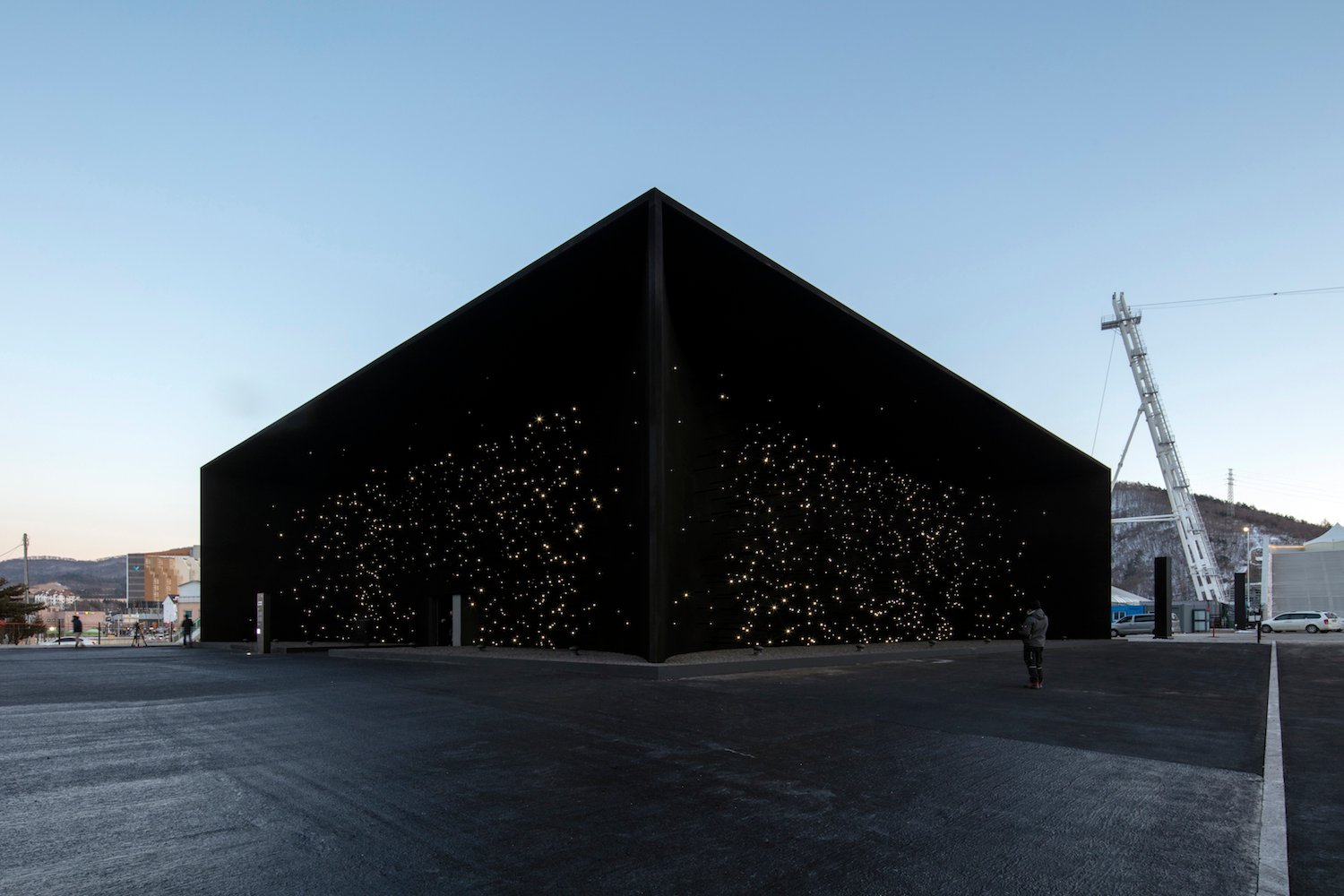
In addition to witnessing world-class feats of athleticism—and a North Korean “art troupe”—visitors to the Winter Olympics in Pyeongchang, South Korea, will have the chance to see “the darkest building on earth.” Designed by British architect Asif Khan, the Hyundai Pavilion in Olympic Park is a veritable black hole with over 30-foot-tall walls coated in Vantablack, the darkest material ever made. The result is a stunning optical illusion.
“From a distance, the structure has the appearance of a window looking into the depths of outer space. As you approach it, this impression grows to fill your entire field of view,” Khan said in a statement. “So, on entering the building, it feels as though you are being absorbed into a cloud of blackness.”
Because Vantablack absorbs 99.96 percent of light, it makes any surface look like a flat, featureless void. As such, the facade of Khan’s pavilion, which he described to CNN as “a schism in space,” is not what it appears: “flat” walls covered in thousands of twinkling lights are actually parabolic facades, curving inward from the corners and ceiling. Each light is on the end of a rod, all of which protrude from the building a different length. The building looks like nothing so much as a field of stars floating in midair.
Asif Khan’s Hyundai Pavilion featuring Vantablack at the Pyeongchang Winter Olympics. Photograph courtesy of Luke Hayes/Hyundai.
Vantablack has become a flashpoint of controversy thanks to British Indian artist Anish Kapoor, who licensed the material’s exclusive use in works of art. Khan began working with Surrey NanoSystems in 2013, a year before they announced the invention of Vantablack, and is the first person to use the groundbreaking material in architecture.
“This is the beginning of a nano-materials revolution,” Khan told The Art Newspaper. “What Kapoor has done, and what we are doing is the tip of the iceberg.” Previously, the architect created a “selfie” pavilion with a screen that morphed to mimic viewers’ faces for the 2014 Olympics and had also proposed an unrealized pavilion featuring Vantablack for the 2015 Milan Expo.
The team at Surrey had to develop a new form of Vantablack, VBx2, to make Khan’s vision a reality. The original Vantablack was incredibly delicate, a dense network of long carbon nanotubes that had to be grown on a given surface. VBx2 is applied using a spray, but don’t expect to get your hands on it any time soon.
Asif Khan’s Hyundai Pavilion, interior, at the Pyeongchang Winter Olympics. Photograph courtesy of Luke Hayes/Hyundai.
“It’s never going to be a retail product,” Ben Jensen, chief technical officer of Surrey Nanosystems, told the Guardian. “It has to be applied by specialist contractors trained by us, using a technique that forms a consistent nanostructure. It doesn’t come in a spray can.” (Kapoor has his own special art version, Vantablack S-VIS, and his studio has been trained in its use.)
In jarring contrast to the pavilion’s jet-black exterior, the inside of the space is a bright white. Inspired by Hyundai’s new hydrogen fuel cell vehicle, Khan has created a “water room,” which produces 25,000 water droplets every minute. The liquid flows in tiny rivulets across the room, a puddle collecting and then draining every few minutes.
See more photos below:
Asif Khan’s Hyundai Pavilion featuring Vantablack at the Pyeongchang Winter Olympics. Photograph courtesy of Luke Hayes/Hyundai.
Asif Khan’s Hyundai Pavilion featuring Vantablack at the Pyeongchang Winter Olympics. Photograph courtesy of Luke Hayes/Hyundai.
Asif Khan’s Hyundai Pavilion featuring Vantablack at the Pyeongchang Winter Olympics. Photograph courtesy of Luke Hayes/Hyundai.
Asif Khan’s Hyundai Pavilion featuring Vantablack at the Pyeongchang Winter Olympics. Photograph courtesy of Luke Hayes/Hyundai.
Asif Khan’s Hyundai Pavilion featuring Vantablack at the Pyeongchang Winter Olympics. Photograph courtesy of Luke Hayes/Hyundai.
Asif Khan’s Hyundai Pavilion featuring Vantablack at the Pyeongchang Winter Olympics. Photograph courtesy of Luke Hayes/Hyundai.
Asif Khan’s Hyundai Pavilion featuring Vantablack at the Pyeongchang Winter Olympics. Photograph courtesy of Luke Hayes/Hyundai.